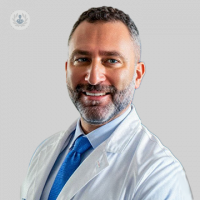The Stockholm3 test for early prostate cancer detection
Written in association with:The Stockholm3 test is a clinical blood test that has transformed the way in which aggressive prostate cancer is detected among patients, increasing early detection and improving treatment outcomes.
Here to provide an expert insight into the Stockholm3 test, including how it differs from the traditional PSA test, is Mr Giangiacomo Ollandini, renowned consultant urological surgeon based in London.

What is the Stockholm3 test, and how does it differ from traditional screening methods for prostate cancer?
Prostate cancer is one of the most commonly diagnosed cancers among men. According to statistics, one in eight men will receive a diagnosis of prostate cancer in their life.
So far, there has mostly been a reliance on a single marker called PSA for the detection of prostate cancer - the accuracy of which is quite not precise. This has led to overtreatment for cancers that otherwise would not grow and missing cancers for those that do not increase this value.
Now, a group in Stockholm has developed an algorithm to improve the detection of aggressive prostate cancers, avoiding unnecessary biopsies. This algorithm, along with certain biomarkers and clinical data, is the basis of the Stockholm3 test, which provides a much more accurate prediction in terms of the probability of having prostate cancer.
What are the key biomarkers analysed in the Stockholm3 test?
It is a combination of factors – not only biomarkers – that are analysed, including:
- The patient’s age
- The patient’s family history of prostate cancer, if applicable
- The results of previous biopsies
- The information from the clinician
Of course, the first biomarker that is checked is the PSA, because the PSA test has been indicated for patients who have at least 1.5 nanograms per millilitre of PSA.
As well as this, there are also other more complex biomarkers and a number of genetic markers that are analysed, including a genetics score that is based off the different options that we as human beings have of expressing the same DNA. This is called polymorphism.
Finally, the outcome of the prostate examination is taken into consideration as well, and everything is included in the data that is submitted to the group in Stockholm.
What are the advantages of using the Stockholm3 test in terms of reducing unnecessary biopsies and improving risk stratification (surgical risks) for patients?
Results have been published in international peer-reviewed journals, but - very important for us in the UK - the National Institute of Clinical Excellence (NICE) has also done a thorough review of the product. In the review, NICE has highlighted how the Stockholm3 test is able to reduce the number of biopsies overall by 32 per cent, avoiding up to 44 per cent of benign biopsies (biopsies that do not need to be done because there is no cancer).
Obviously, a biopsy is a simple procedure, but it can also have a burden in terms of side effects and risks, because it is still an invasive procedure.
How can the results of the Stockholm3 test be interpreted? What are the recommended follow-up actions based on different risk categories?
The results arrive in the form of a traffic light:
- A green light that corresponds to a low risk
- A yellow light that corresponds to a normal risk
- A red light that corresponds to a high risk
There is also specific advice included regarding the timescale and the follow-up actions to be taken. The latter will vary depending on whether a patient is already under the care of a clinician or not.
In addition, there is a score measured in percentage points that shows the risk of having a clinically significant prostate cancer. It is recommended that when this risk is 11 per cent or higher, the patient should go through the standard pathway for the diagnosis of prostate cancer. This normally involves an MRI scan and a decision on whether or not to undergo a prostate biopsy.
What are the potential limitations or challenges associated with implementing the Stockholm3 test in clinical practice?
First of all, the Stockholm3 test is a new technology, even though it is based on a sequence of more than 75,000 patients. This sequence is the strength of the test if used in clinical practice, especially in places like the UK, where the NHS has a unique structure.
Secondly, the Stockholm3 test is not very well understood in terms of how it could be a gamechanger in the long-term, especially in the decision-making stage of this type of scenario.
Finally, the data regarding BAME (Black, Asian and Minority Ethnic) communities is rather limited for the moment. We still need to wait for further developments of the science.
Mr Giangiacomo Ollandini is a revered consultant urological surgeon with over a decade of experience in providing diagnosis and treatment for prostate cancer.
If you have symptoms that could indicate prostate cancer, or you would simply like to know more about the Stockholm3 test, do not hesitate to book an appointment with Mr Ollandini via his Top Doctors profile today.


